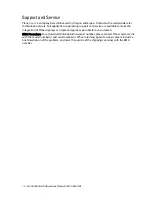
EL320.240.36-HB Operations Manual (020-0346-00A)
9
Internal Frame Buffer
This display includes an internal frame buffer. The display frame rate and the
display brightness are independent of user-supplied input data timing. The
display frame rate can be controlled through the digital dimming feature as
described below.
CAUTION: The display includes an internal frame buffer. In order to blank the
display image in the event of system malfunction, pull down the VS signal.
Dimming
There are two standard methods for dimming the EL320.240.36-HB display.
Analog dimming using the J2 dimming connector described on page 7 of this
manual allows for manual dimming from 100% to approximately 5% of the full
brightness. To perform analog dimming, connect a 50 k ohm variable resistor
between LUMA and GND. Alternatively, an external voltage or current mode
D/A converter may be used to facilitate dimming by sinking a maximum of 250
µA (for maximum dimming) from LUMA to GND on the input connector. Open
circuit voltage is 4 V nominal.
The internal scan frequency can be controlled via the LUMC and LUMD inputs.
When LUMC and LUMD are left open, the scan rate is determined by the SCAN
signal (pin 4) on the data input connector. With the combination of LUMC and
LUMD, the following and luminance levels are obtained:
Table 5. Luminance Control
Approx. Relative luminance 100% 75% 50% 30% 100% 50%
LUMD (internal pull up)
High
High
Low
Low
Open
Open
LUMC (internal pull up)
High
Low
High
Low
Open
Open
SCAN (J1 pin 4)
Open
Open
Open
Open
High
Low
Self-Test Mode
The display incorporates a self-test mode composed of two patterns displayed
at maximum frame rate for approximately 30 seconds each, and then
repeated. The patterns are as follows:
50/50 Checkerboard
and
Full On
. The
self-test mode is entered by leaving pin 3 on J1 unconnected or pulled high.
This pin has an internal pull-up. Connect pin 3 on J1 to Ground for normal
display operation.



































